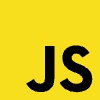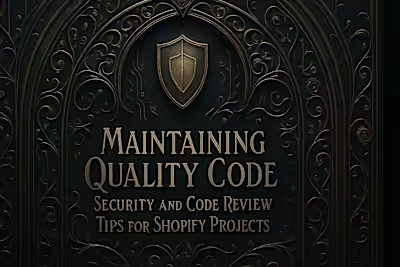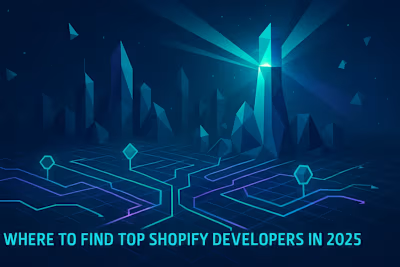How to Write a Job Description That Attracts Expert Shopify Developers

How to Write a Job Description That Attracts Expert Shopify Developers
The Core Components of an Effective Job Description
Crafting a Clear and Specific Job Title
Writing an Engaging Company and Project Overview
Detailing Key Roles and Responsibilities
Defining Technical Skills and Qualifications
Essential vs. 'Nice-to-Have' Skills
Specifying the Technology Stack
Selling the Opportunity: Culture, Benefits, and Salary
Highlighting Company Culture and Growth Opportunities
The Importance of Salary Transparency
References
How to Write a Job Description That Attracts Expert Shopify Developers
A well-crafted job description is your first, and most important, tool in the hiring process. It's a marketing document designed to sell your opportunity to top talent. After you've determined where to find Shopify developers, this is your crucial next step. A clear and compelling post not only attracts the right candidates but also sets the stage for the interview process, helping you prepare your interview questions. If you'd rather connect with top talent directly, you can hire an expert Shopify developer on Contra.
Think of your job description as a first date conversation. You want to share enough to spark interest without overwhelming, and you definitely want to put your best foot forward. The difference between a mediocre posting and a great one can mean attracting five qualified candidates versus fifty.
In today's competitive market for Shopify talent, generic job descriptions simply won't cut it. Developers are looking for specific information about the role, the tech stack, and what makes your company worth their time. They're evaluating you just as much as you're evaluating them.
The Core Components of an Effective Job Description
A great job description needs to be clear, concise, and comprehensive. It should give a developer all the information they need to decide if they are a good fit for the role.
Let's break this down into digestible pieces. Your job description is essentially answering three key questions: What will they do? What skills do they need? Why should they care? Each component of your posting should address one of these questions directly.
The best job descriptions read like a conversation, not a legal document. They're informative without being dry, specific without being overwhelming. Remember, you're trying to attract creative problem-solvers who build amazing online experiences. Your posting should reflect that energy.
Crafting a Clear and Specific Job Title
Avoid generic titles. Be specific about the role and experience level, such as 'Senior Shopify Theme Developer' or 'Shopify App Developer (React & Node.js)'. A specific title is more searchable and attracts candidates with the right expertise.
Generic titles like "Web Developer" or "E-commerce Developer" cast too wide a net. You'll spend hours sifting through applications from candidates who've never touched Shopify. Worse, the developers you actually want might skip right past your posting because it doesn't clearly match their skills.
Consider what developers are actually searching for. They're typing "Shopify developer jobs" or "Shopify Plus developer remote" into job boards. Your title needs to match their search terms while accurately describing the role. If you need someone who specializes in custom app development, say so. If the role focuses on theme customization, make that clear.
The seniority level matters too. A "Junior Shopify Developer" attracts different candidates than a "Lead Shopify Developer." Be honest about the experience level you need. Inflating the title might attract more applicants, but they won't be the right ones.
Writing an Engaging Company and Project Overview
This is your elevator pitch. Briefly introduce your company, its mission, and the project the developer will be working on. Highlight what makes your company a great place to work and the impact the developer will have.
Start with a hook. What's exciting about your company or project? Maybe you're disrupting the pet food industry with a subscription model. Perhaps you're helping small businesses compete with Amazon. Whatever it is, lead with the impact.
Keep it conversational and authentic. Skip the corporate jargon about "synergizing paradigms" or "leveraging best-in-class solutions." Instead, talk about real problems you're solving and real people you're helping. Developers want to build things that matter.
Paint a picture of what their day might look like. Will they be working on a high-traffic store processing thousands of orders? Are they building custom features that don't exist anywhere else? Give them something to get excited about.
Don't forget to mention the team they'll be joining. Developers care about who they'll work with. A brief mention of team size, structure, and collaboration style goes a long way. Something like "You'll join our team of five developers who believe in clean code, continuous learning, and actually enjoying Monday mornings" tells them more than any mission statement could.
Detailing Key Roles and Responsibilities
Use a bulleted list to clearly outline the primary responsibilities. Focus on outcomes rather than just tasks. For example, instead of 'Write code,' use 'Develop, test, and deploy new user-facing features on our Shopify Plus store.'
The key word here is outcomes. Developers don't get excited about tasks; they get excited about solving problems and building cool stuff. Frame responsibilities around what they'll achieve, not just what they'll do.
Here's what this looks like in practice. Instead of "Maintain existing codebase," try "Optimize our checkout flow to reduce cart abandonment by 20%." Instead of "Fix bugs," write "Ensure 99.9% uptime for our store serving 50,000 daily visitors."
Be specific about the types of projects they'll tackle. Will they be creating custom product configurators? Building integrations with third-party logistics providers? Developing headless commerce solutions? The more specific you are, the better candidates can envision themselves in the role.
Don't overwhelm with a laundry list of 20 responsibilities. Stick to 5-8 key areas that represent the core of the job. If everything is a priority, nothing is a priority. Focus on what they'll spend most of their time doing.
Remember to include collaboration aspects. Modern development isn't a solo sport. Mention if they'll be working with designers, partnering with marketing teams, or mentoring junior developers. This gives a fuller picture of the role.
Defining Technical Skills and Qualifications
This section must be precise. Listing every technology ever used can deter qualified candidates. Instead, focus on what's truly necessary for the role.
Think about it from the developer's perspective. They're scanning job descriptions, trying to figure out if they're qualified. When they see a list of 30 required technologies, including some they've never heard of, they move on. Even if they could do the job brilliantly.
The goal isn't to find someone who checks every single box. It's to find someone who can solve your problems and grow with your team. Sometimes the best developer for your team is the one who knows 80% of your stack but brings fresh perspectives and eagerness to learn.
Essential vs. 'Nice-to-Have' Skills
Clearly separate required skills from preferred qualifications. For a Shopify developer, essentials might include Liquid, JavaScript, HTML/CSS, and experience with Shopify APIs. 'Nice-to-haves' could be React, experience with Shopify Plus, or specific app development knowledge.
Start with the absolute must-haves. What skills are non-negotiable for day-one productivity? For most Shopify roles, this includes:
Essential skills typically cover the core Shopify ecosystem. Liquid templating is almost always essential since it's Shopify's templating language. JavaScript proficiency is crucial for any interactive features. HTML and CSS are the building blocks of any web development. Experience with Shopify's API is vital for custom functionality.
But here's where many job descriptions go wrong. They list every possible skill as "required." Do you really need someone who knows GraphQL, REST APIs, React, Vue, Angular, Node.js, Python, and Ruby? Probably not. Be realistic about what the job actually requires.
Nice-to-have skills are where you can dream a little. These are skills that would make someone even more valuable but aren't deal-breakers. Maybe experience with Shopify Plus would be great since you're planning to upgrade. Perhaps React knowledge would help with that headless commerce project you're considering next year.
The distinction matters because it affects who applies. A developer who's perfect for your role might skip your posting because they don't have one "required" skill that's actually just nice to have. Meanwhile, you're missing out on great talent over something they could learn in a few weeks.
Specifying the Technology Stack
Be explicit about the tools and technologies the developer will use daily. This helps candidates self-select and ensures a better technical fit. Mention version control (like Git), project management tools, and any specific frameworks.
Transparency about your tech stack serves two purposes. First, it helps developers understand if they'll be comfortable with your tools. Second, it shows you're organized and professional about your development process.
Start with the development environment. What version control system do you use? Most teams use Git, but specify if you're using GitHub, GitLab, or Bitbucket. Mention your deployment process. Do you use continuous integration? What's your testing approach?
List the specific Shopify tools and apps that are central to the role. Are you using specific page builders like Shogun or GemPages? Do you rely heavily on certain apps like Klaviyo for email marketing or Gorgias for customer service? These details matter.
Don't forget about project management and communication tools. Will they be using Jira, Asana, or Trello? Is communication primarily through Slack, Microsoft Teams, or something else? These might seem like minor details, but they affect daily work life.
If you're using any unusual or cutting-edge technologies, explain why. Developers appreciate understanding the reasoning behind tech choices. It shows thoughtfulness and can actually be a selling point for developers who want to work with modern tools.
Selling the Opportunity: Culture, Benefits, and Salary
Top developers have options. Your job description must convince them why they should choose you. This section is about showcasing the value you offer beyond the technical work.
Remember, skilled Shopify developers are probably looking at multiple opportunities. They're not just evaluating whether they can do the job – they're evaluating whether they want to. This is where you need to shift from describing to selling.
The best developers care about more than just the code they write. They want to know about the people they'll work with, the problems they'll solve, and yes, how they'll be compensated. Being open about these aspects shows confidence and respect.
Highlighting Company Culture and Growth Opportunities
Describe the team structure, development process (e.g., Agile), and opportunities for professional growth. Developers want to know they'll be able to learn and advance their careers.
Culture isn't just about ping pong tables and free snacks (though those are nice). It's about how work gets done, how decisions are made, and how people treat each other. Be specific about what makes your culture unique.
Talk about your development process. Do you follow Agile methodologies? How do you handle code reviews? What's your approach to technical debt? Developers want to join teams that value quality code and sustainable practices.
Growth opportunities are huge for attracting top talent. Nobody wants to feel stuck in the same role forever. Be clear about potential career paths. Can a senior developer become a team lead? Are there opportunities to learn new technologies? Do you support conference attendance or online courses?
Share real examples when possible. Instead of saying "we value continuous learning," say "Last quarter, our team members attended React Summit and completed AWS certifications, with full company support." Concrete examples beat vague promises every time.
Don't oversell or make promises you can't keep. If you're a small startup, you probably can't offer the same formal training programs as a large corporation. But you can offer hands-on experience with diverse projects, direct impact on company success, and the chance to wear multiple hats.
The Importance of Salary Transparency
Including a salary range is one of the most effective ways to attract qualified applicants who fit your budget. It shows respect for the candidate's time and significantly improves the quality of applications.
Let's be honest – salary is often the elephant in the room during hiring. Everyone's thinking about it, but many companies still play coy. This wastes everyone's time. A developer might go through multiple interviews only to discover the salary is 30% below their expectations.
Posting a salary range immediately filters your applicant pool in the best way possible. Developers who need more won't apply. Those within your range will be genuinely interested. You'll spend less time on dead-end conversations and more time with viable candidates.
The range should be realistic and fairly narrow. A range of "$60,000 - $150,000 DOE" is meaningless. Something like "$95,000 - $115,000 based on experience" gives real information. Be prepared to pay at the top of your range for exceptional candidates.
Beyond base salary, mention other compensation elements. Do you offer equity? Performance bonuses? Profit sharing? These can make a significant difference, especially for startups that might not match corporate salaries but offer upside potential.
Don't forget about benefits that affect take-home value. Health insurance, retirement matching, and paid time off all factor into total compensation. A slightly lower salary with excellent benefits might be more attractive than higher pay with minimal benefits.
If you're hiring contractors or freelancers, be clear about rates and payment terms. Specify whether rates are hourly or project-based. Mention payment schedules. These details help freelancers decide if you're a good client fit.
Remember, transparency builds trust. When you're upfront about compensation, candidates see you as honest and respectful. That positive impression carries through the entire hiring process and beyond.
References
Like this project
Posted Jul 4, 2025
Learn how to craft a clear, compelling, and effective job description to attract top-tier Shopify development talent for your e-commerce project.










